The architectural style known as Vilnius Baroque is a regional variant of the Late Baroque in this specific part of Lithuania. Since this style is so unique, I’m dedicating this entire post to the amazing churches in the city of Vilnius.

- Churches in Vilnius
- Vilnius Baroque
- 12 Most Magnificent Churches
- Church of Saints Peter and Paul
- Church of Saint Anne, Saint Francis, and Saint Bernardine
- Cathedral of Saints Stanislaus and Ladislaus
- Church of Saint Theresa
- Holy Trinity Uniate Church
- Orthodox Church of the Holy Spirit
- Church of Saint Casimir
- Church of the Ascension
- Saint Catherine's Church
- Church of Saint Archangel Raphael
- Dominican Church of the Holy Spirit
- Church of Saint John the Baptist and Saint John the Apostle and Evangelist
- 5 Most Beautiful Orthodox Churches
- How to Get Around
- Visiting Organized
- Map
- Pinnable Pictures
Churches in Vilnius
The strikingly high density of Baroque churches in Vilnius is by no means a coincidence. It is the result of a complex history in which religion, politics, and culture were closely intertwined.
Lithuania was the last pagan country in Europe to officially convert to Christianity in 1387. By European standards, this was quite late.
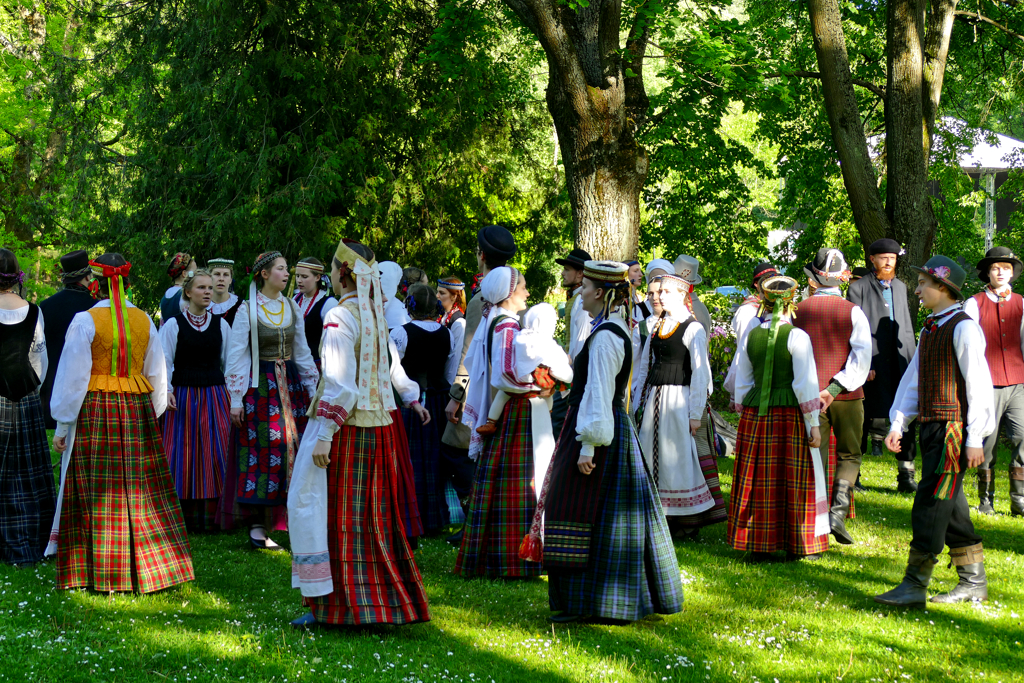
During the Polish-Lithuanian Commonwealth from the 16th to the 18th centuries, Lithuania was strongly influenced by Catholicism, thanks to the nobility. Magnificent churches were founded as symbols of faith and social prestige. In addition, religious orders such as the Jesuits, Dominicans, Bernardines, and Franciscans also built churches and monasteries. There were also strong Orthodox, Jewish, Protestant, and later Uniate, hence, Greek Catholic, communities. In fact, from the 16th century onward, Vilnius became a religious melting pot.
Why Baroque?
After the Reformation in the 16th century, however, Lithuania became a significant center of the Counter-Reformation. The Catholic Church deliberately used Baroque as a style to emotionally connect with the faithful and to contrast the splendor of Catholic liturgy with Protestant austerity. Churches became not only places of worship, but also powerful symbols of Catholicism. It was fortunate that the Baroque style, characterized by emotional drama, opulent forms, and lighting effects, was en vogue throughout Europe at the time. This offered the appropriate tool for expressing power, piety, and cultural splendor.

Giovanni Battista Frediani, Giovanni Pietro Perti, and other Italian architects brought the Baroque from Rome to Vilnius. Then, local architects developed a distinctive style from it, the so-called Vilnius Baroque. After the partition of the aristocratic republic, Lithuania fell to Russia, which supported the Orthodox Church and restricted Catholic institutions. During the Soviet era, many churches were closed or converted to other uses, yet, many were restored after 1990.
Vilnius Baroque
The architectural style known as Vilnius Baroque is a regional variant of the Late Baroque in the Vilnius region. From there, this style spread throughout the country, reaching Latvia, Belarus, and present-day northeastern Poland.
The architects of the Vilnius Baroque were largely Saxon master builders who settled in Poland-Lithuania in the early 18th century. The Silesian architect Johann Christoph Glaubitz is considered a pioneer.

Churches, palaces, and magnificent townhouses were built in the Vilnius Baroque style, which Rococo replaced in the mid-18th century.
Vilnius Baroque is characterized by an upwardly symmetrical orientation, two towers, and a rather lighter appearance compared to Classical Baroque. This contrasts with the Baroque style prevalent in Lithuania in the late 17th and early 18th centuries. Other features include decorated compartments, wavy cornices and walls, as well as bright colors.
12 Most Magnificent Churches
Vilnius’ Baroque churches are the result of spiritual, artistic, and political fervor. As you stroll through Vilnius’ old town, you’ll encounter not only magnificent architecture, but also a cultural identity shaped by faith throughout the centuries. Vilnius is thus not only a place of beauty, but a window into the history of faith in Eastern Europe. In fact, Vilnius is even considered one of the most Baroque cities in Europe north of the Alps.
Here are the twelve most magnificent churches Vilnius has to offer, albeit not all of them are in the famed Baroque style. Also, note that since it’s difficult to rank Vilnius’ churches as beauty is subjective, I’m beginning my list with the poster child, the Church of Sts. Peter and Paul. It stands on the northern outskirts of the city center and is regarded as one of the finest examples of Baroque architecture in Eastern Europe.
Church of Saints Peter and Paul
The Roman Catholic Church of Saints Peter and Paul is more than just a place of worship. It is an embodiment of the Counter-Reformation’s emphasis on awe and emotional engagement through sacred art.
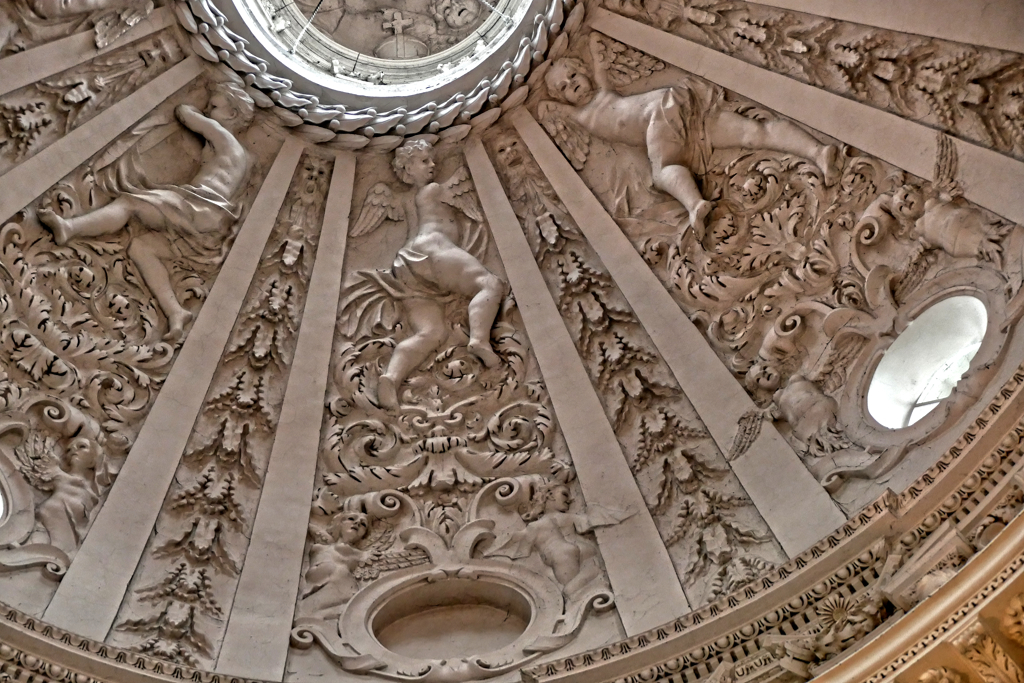
Michał Kazimierz Pac, a nobleman and military commander of the Polish–Lithuanian Commonwealth, commissioned the building in the 17th century. The Italian architects Giovanni Pietro Perti and Giovanni Maria Galli oversaw the construction which was concluded in the 1670s.
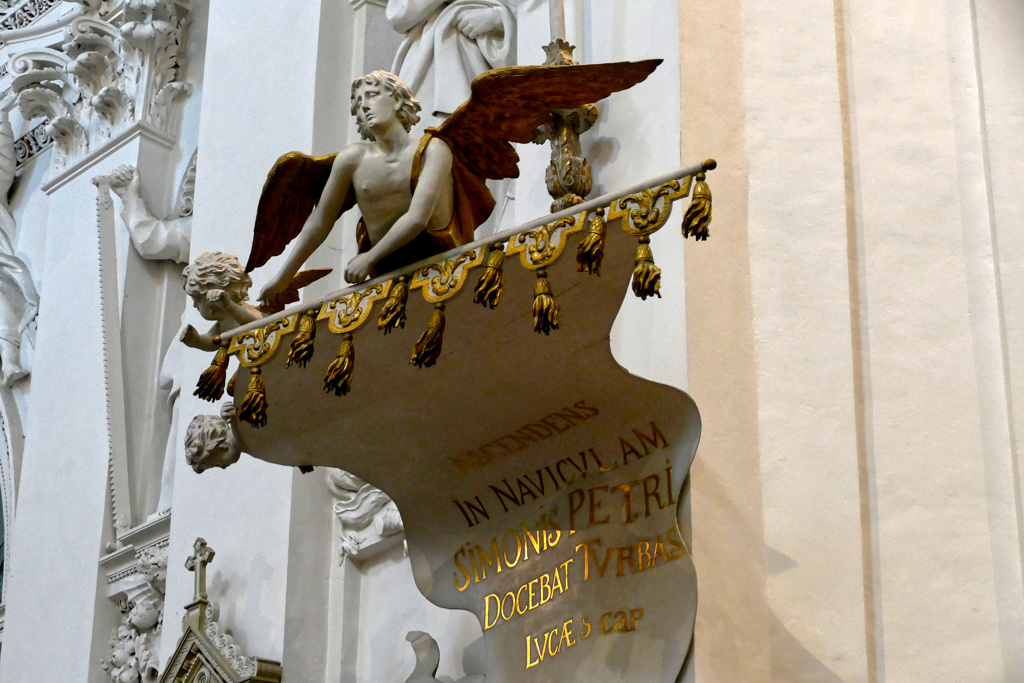
From the outside, the church appears relatively modest, with a pale, classical façade. However, inside, you’ll find a breathtaking interior, often described as a sculptural wonderland. Over 2,000 stucco figures such as angels, saints, and allegorical representations, adorn the walls and vaulted ceilings. This ethereal decoration, crafted in fine stucco by Perti and Galli was designed to evoke a sense of heavenly transcendence. The purity of white creates an atmosphere of divine light and serenity.
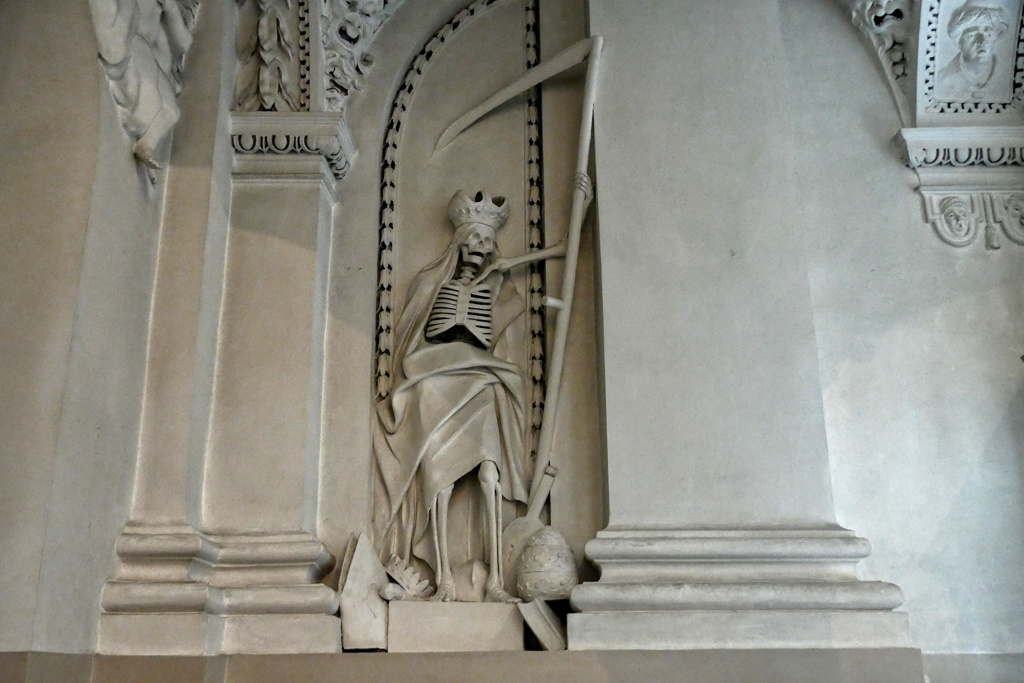
The Church of Saints Peter and Paul is open every day from 7 a.m. to 6.30 p.m.
Church of Saint Anne, Saint Francis, and Saint Bernardine
On the edge of Vilnius’ old town stands the Church of Saint Anne, together with the Church of Saint Francis and Saint Bernardine. These houses of worship are often collectively referred to as the Bernardine ensemble. They form one of the most striking and historically rich architectural complexes in all of Lithuania.
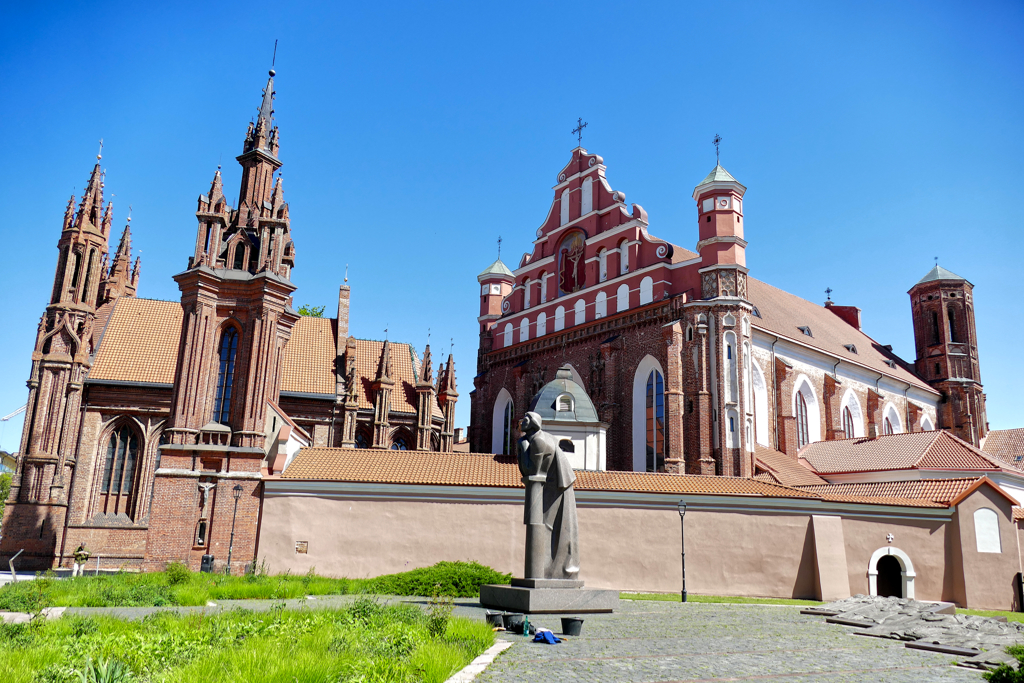
The Church of Saint Anne, constructed at the end of the 15th century, is a masterpiece of Flamboyant Gothic architecture. Its intricate facade, built from 33 different kinds of red brick that were arranged in an almost lace-like pattern, makes it absolutely unique.
Adjacent to Saint Anne’s stand the Churches of Saint Francis and Saint Bernardine. These much larger structures were originally built by Bernardine monks in the 15th century and expanded in the 16th century. While its foundation is Gothic, it has undergone several renovations, incorporating Renaissance and Baroque elements, especially in the interior.
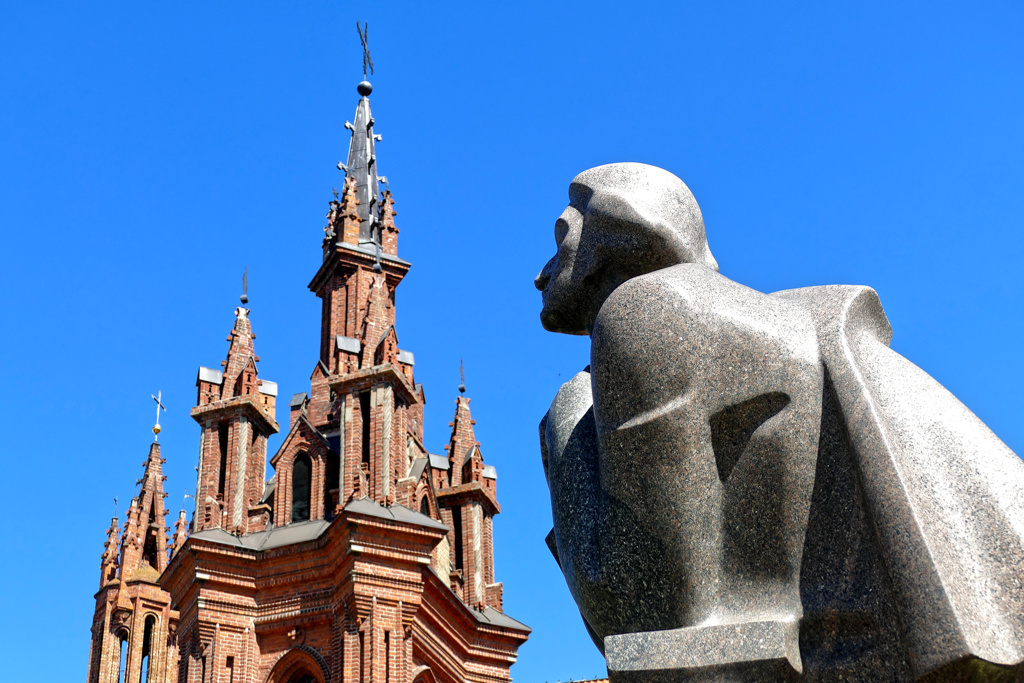
Inside the church are rich frescoes, wooden altars, and vaulted ceilings. Unlike the refined elegance of Saint Anne’s, the Bernardine Church evokes a sense of monastic solidity and spiritual grandeur. The adjoining monastery complex once played a major role in Vilnius’s religious and educational life.
Together, these two churches symbolize the resilience of Lithuanian cultural and religious identity as they survived wars, occupations, and Soviet-era suppression.
Cathedral of Saints Stanislaus and Ladislaus
The Cathedral of Saints Stanislaus and Ladislaus is commonly known as the Vilnius Cathedral. Standing proudly at the foot of Gediminas Hill, where the pagan sanctuaries of the Grand Duchy once stood, the cathedral represents the country’s enduring Christian heritage and its complex cultural evolution.
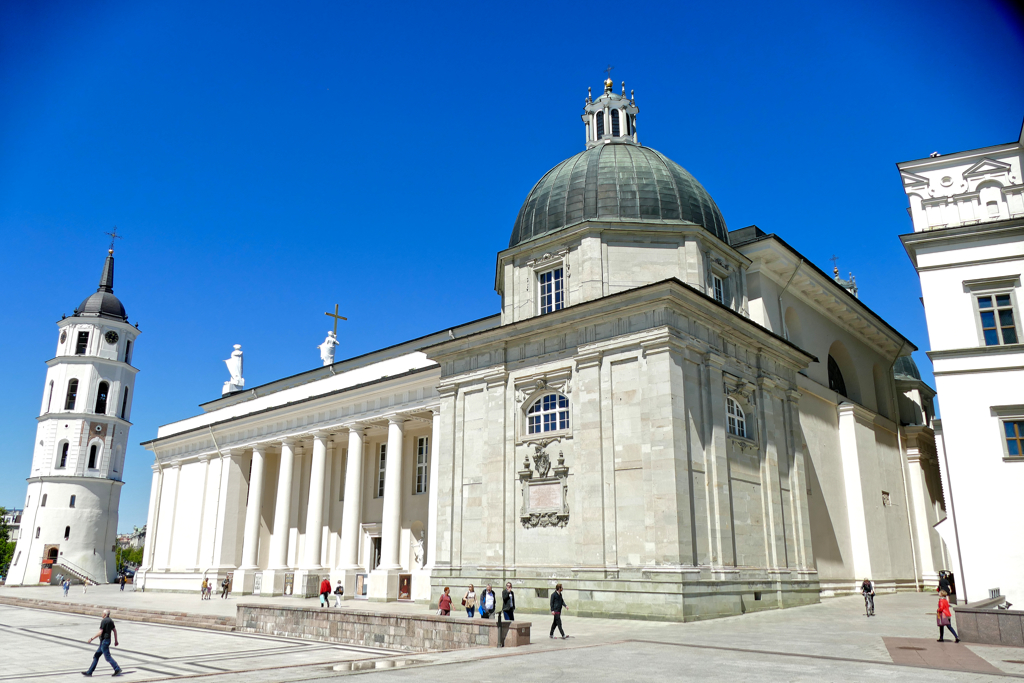
Obviously, the location of the cathedral is no coincidence. Before Lithuania’s official conversion to Christianity in 1387, this site is believed to have been home to a major Baltic pagan temple. After Grand Duke Jogaila’s baptism and Lithuania’s Christianization, the first Catholic cathedral was built here. It was dedicated to Saint Stanislaus, a Polish martyr and patron of Poland, and later also to Saint Ladislaus, a Hungarian king.
The current structure in a striking Neoclassical style, however, dates from the late 18th century and was designed by Laurynas Gucevičius, one of Lithuania’s most prominent architects. Albeit, the Neoclassical architecture overlays earlier Gothic and Renaissance phases, remnants of which are preserved in the crypts and chapels.
To the side stands the Cathedral Bell Tower, originally part of the city’s defensive walls.
More Than Just a House of Worship
Inside, the most renowned feature is the Chapel of Saint Casimir, built in the 17th century in a rich Baroque style. It houses the remains of Saint Casimir, the patron saint of Lithuania.
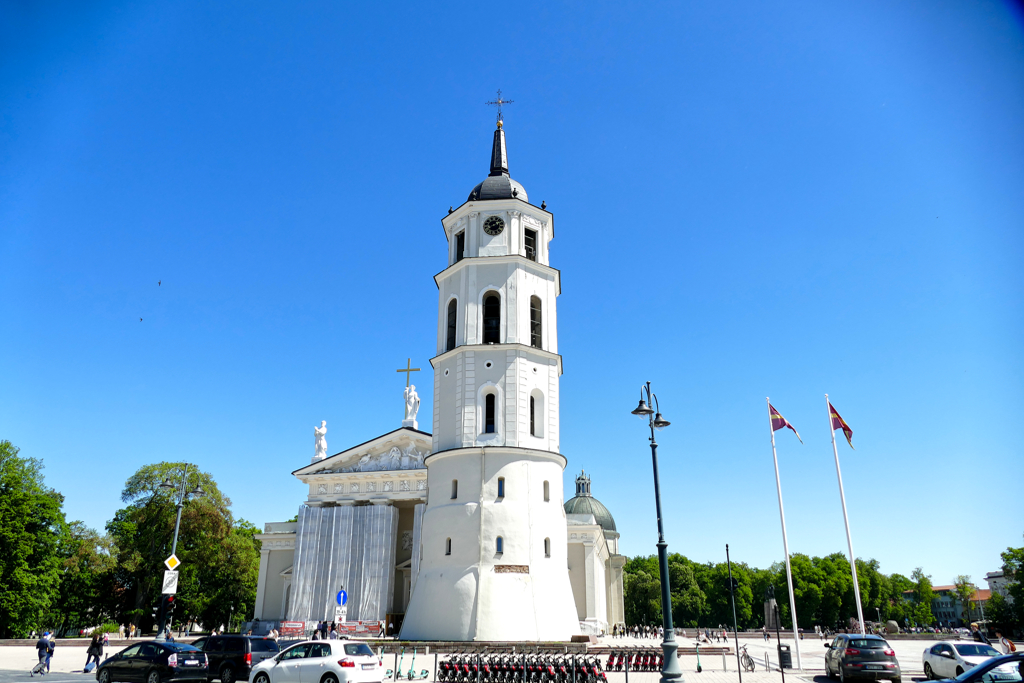
Beneath the cathedral lies a labyrinth of crypts, including the Royal Mausoleum, where members of the Jagiellonian dynasty were laid to rest.
This underscores the cathedral’s role not just as a religious structure, but as a seat of power during the height of the Polish–Lithuanian Commonwealth. After all, the cathedral has also served as a coronation site for grand dukes, a sanctuary during times of upheaval, and as a powerful symbol of national identity, especially during Soviet times.
Church of Saint Theresa
Tucked at the edge of Vilnius’s old town stands the Church of Saint Theresa. It is a serene and striking monument to Lithuania’s spiritual and architectural heritage. Completed in the mid-17th century, this Roman Catholic church was built by the Discalced Carmelites, whose convent once stood beside it. The church, dedicated to Saint Teresa of Ávila, embodies the intense piety and ornate beauty typical of Baroque religious architecture.
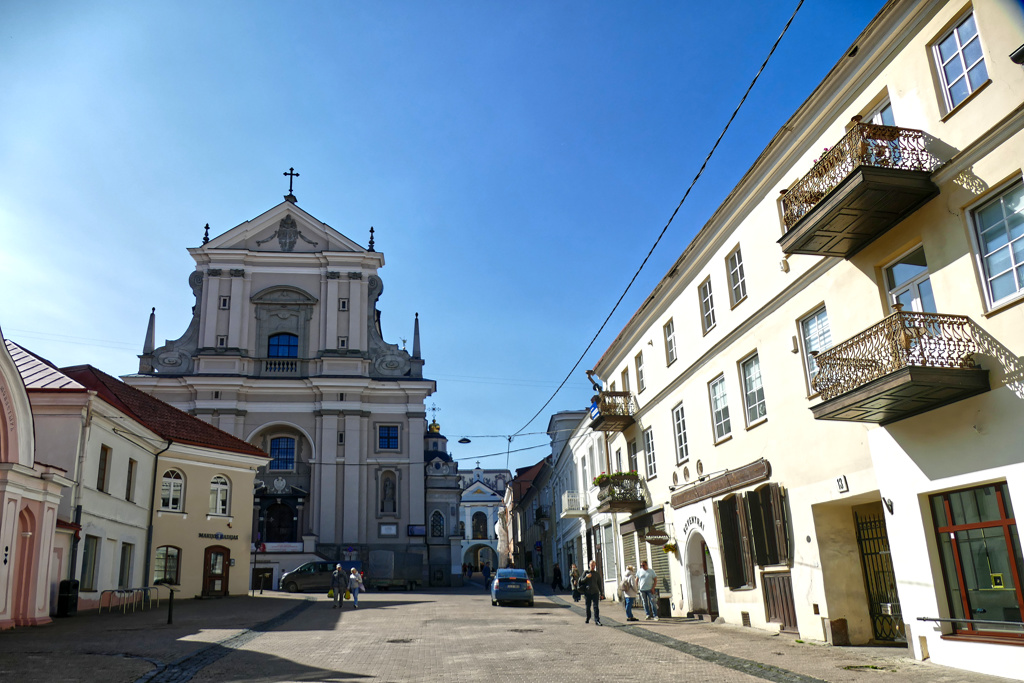
While the church has a rather modest, symmetrical façade, the interior is a symphony of gilded altars, elaborate stucco work, and vivid frescoes. In the classic Baroque fashion, they are all meant to draw the eye to the heavens above. The main altar, with its twisting columns and radiant centerpiece, is particularly striking, devoted to the church’s patron saint.

One of the most notable features of the Church of Saint Theresa is its proximity to the Gate of Dawn. It is the only remaining gate of the original city wall and a site of intense Marian devotion. The close connection between the church and the chapel of the miraculous icon of the Mother of Mercy above the gate underscores Vilnius’s unique blend of architectural grandeur and deeply felt Catholic faith.
Holy Trinity Uniate Church
Just around the corner from the Church of Saint Theresa, the Holy Trinity Uniate Church stands as a profound testament to the city’s complex religious and cultural tapestry.
The church is part of a monastery complex that has been associated with the Order of Saint Basil the Great, a monastic community within the Eastern Catholic Church. Its origins trace back to the early 16th century when it was built under the patronage of Grand Hetman Konstanty Ostrogski. The church was initially Orthodox, but over time, it became a key center for the Greek Catholic Church.
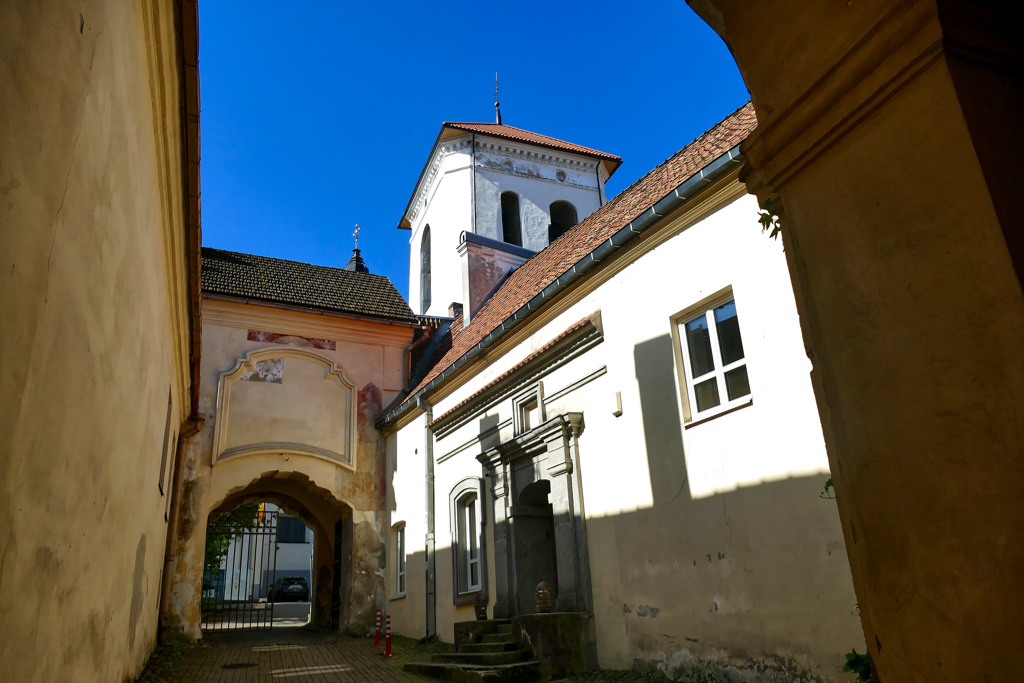
Architecturally, it is a fascinating fusion of styles. Its exterior, with a somewhat austere brick façade, belies the rich and spiritual atmosphere within. The interior features iconostasis elements typical of Eastern Christian worship, blending Eastern and Western characteristics of the Uniate tradition.
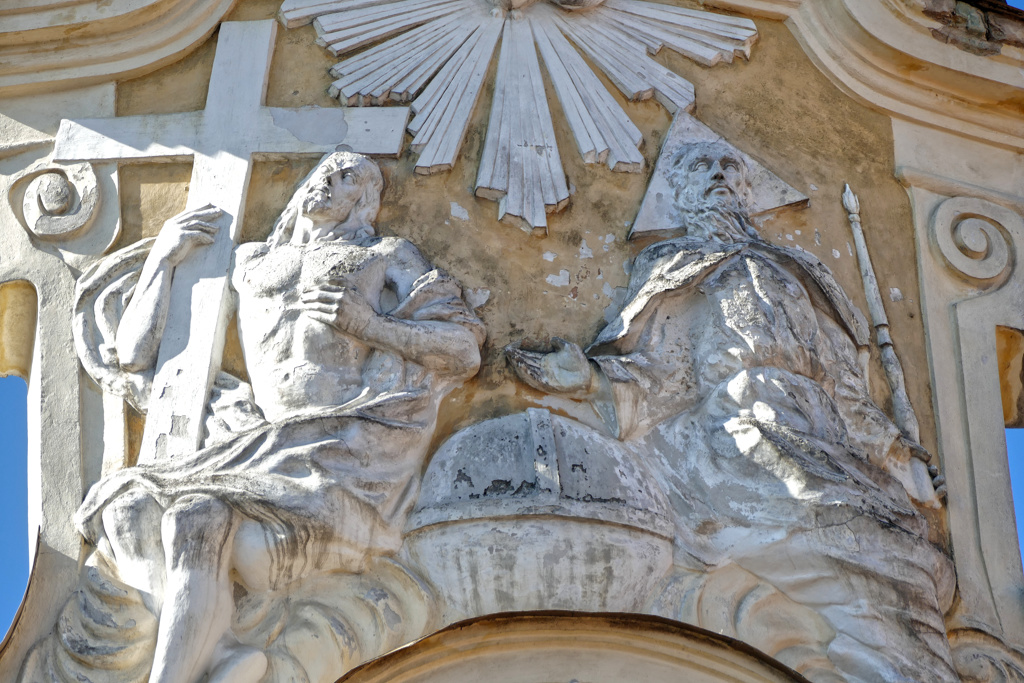
Even more compelling is the church’s role as a hub of Ruthenian religious life and education. For instance, it has owned a printing press that published religious texts in Church Slavonic and Ruthenian.
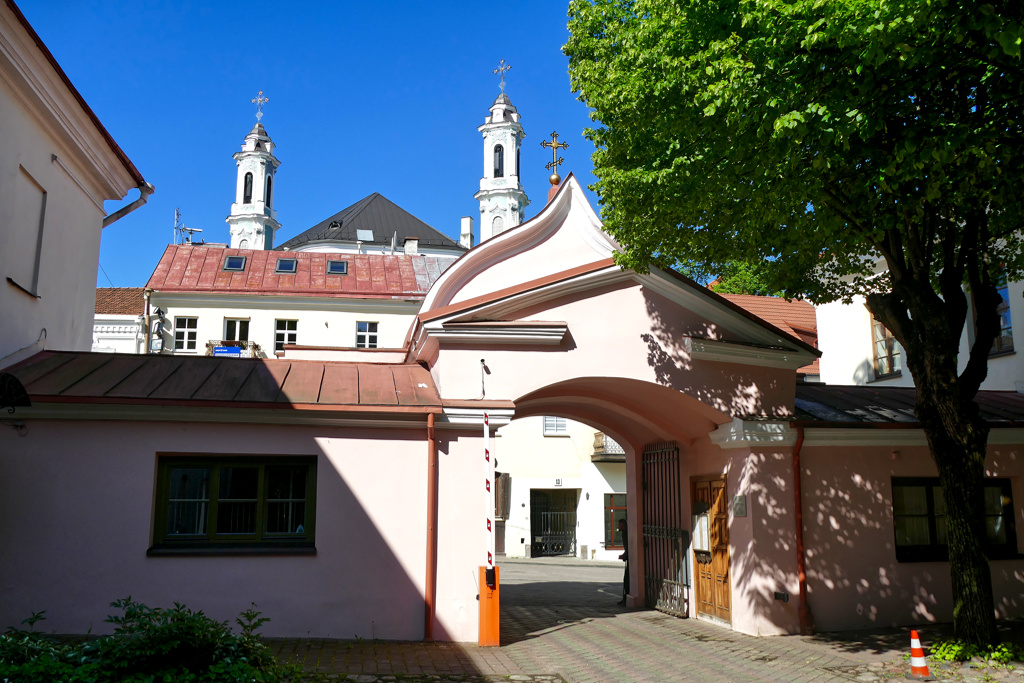
The nearby Basilian monastery once housed scholars, monks, and even political prisoners during tsarist times. The most prominent one was probably Adam Mickiewicz.
Orthodox Church of the Holy Spirit
The density of churches on the southern edge of Vilnius’ old town ist just incredible. They stand literally a couple of meters apart! Just across the street from the Holy Trinity Uniate Church stands in a lush garden the Orthodox Church of the Holy Spirit.
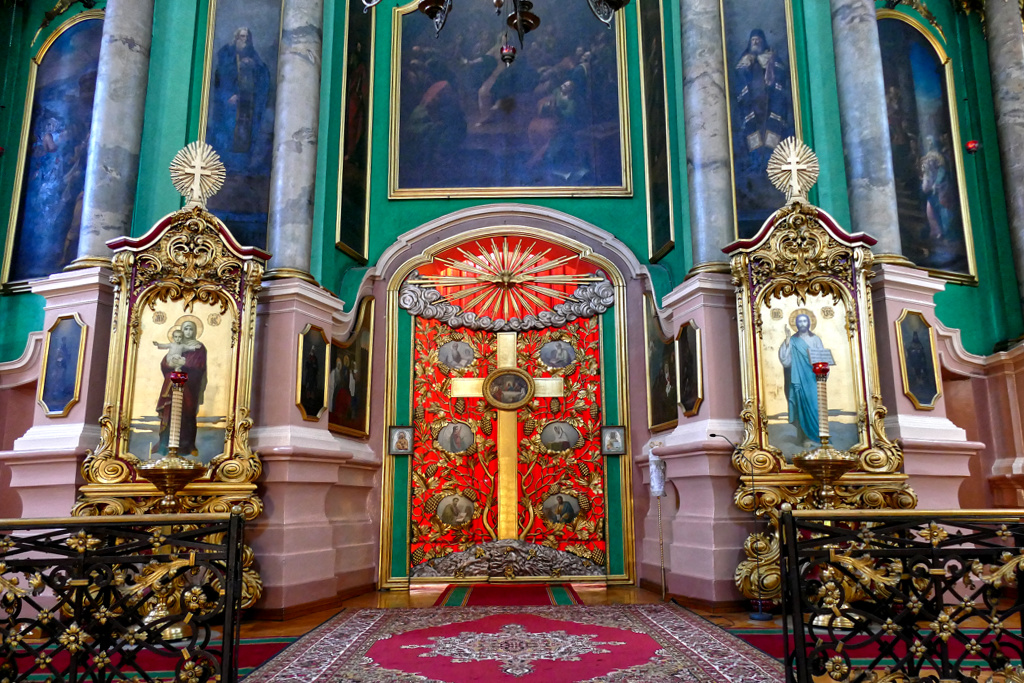
The Baroque-style building, completed in the mid-18th century, rises on the foundations of earlier religious structures dating back to the 14th century and is the main spiritual center for the Russian Orthodox community in Lithuania. Its ornate interior, filled with lavish iconostasis and richly decorated frescoes, envelops visitors in a deeply atmospheric sphere of the sacred.
The Church of the Holy Spirit houses the relics of three Orthodox martyrs, namely the Saints Anthony, John, and Eustathius of Vilnius. They were executed in the 14th century for refusing to renounce their faith under the pressure of pagan rulers. Their relics lie in a silver sarcophagus in the crypt.
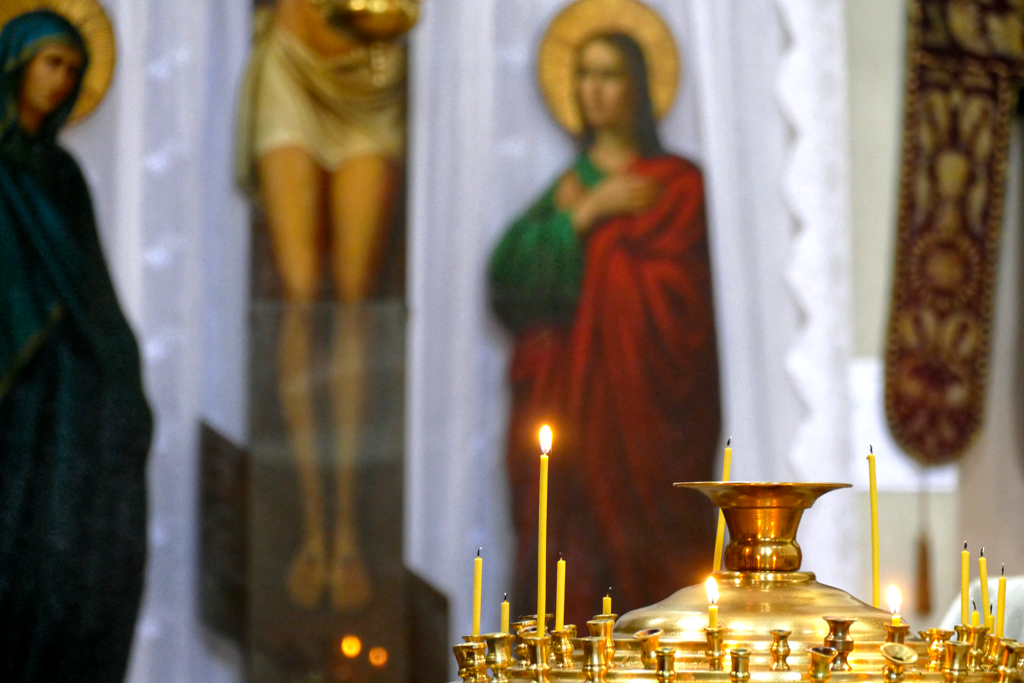
Despite periods of suppression, particularly during Soviet rule, the church remained a bastion of Orthodox faith and identity. Today, its vivid green and white façade, topped with onion domes, continues to draw the faithful and the curious alike. Step in and let the candlelit interior and ancient Slavonic chants carry you into the spiritual heritage of Vilnius.
Vilnius, though predominantly Roman Catholic, has a rich Orthodox heritage dating back to the medieval era. Several Orthodox churches in the city are historically and spiritually significant, especially for the Russian and Belarusian Orthodox communities. I’m introducing the most important Orthodox churches in Vilnius at the end of this post.
Church of Saint Casimir
Saint Casimir’s is one of the city’s most important churches. Obviously, it is named after Saint Casimir, the patron saint of Lithuania.
Construction took place between 1604 and 1609. The interior was finally completed in 1615. It became the parish church of the Jesuits, who came to Vilnius in 1569. From Vilnius, the Jesuits were to support the Counter-Reformation in the Grand Duchy of Lithuania.
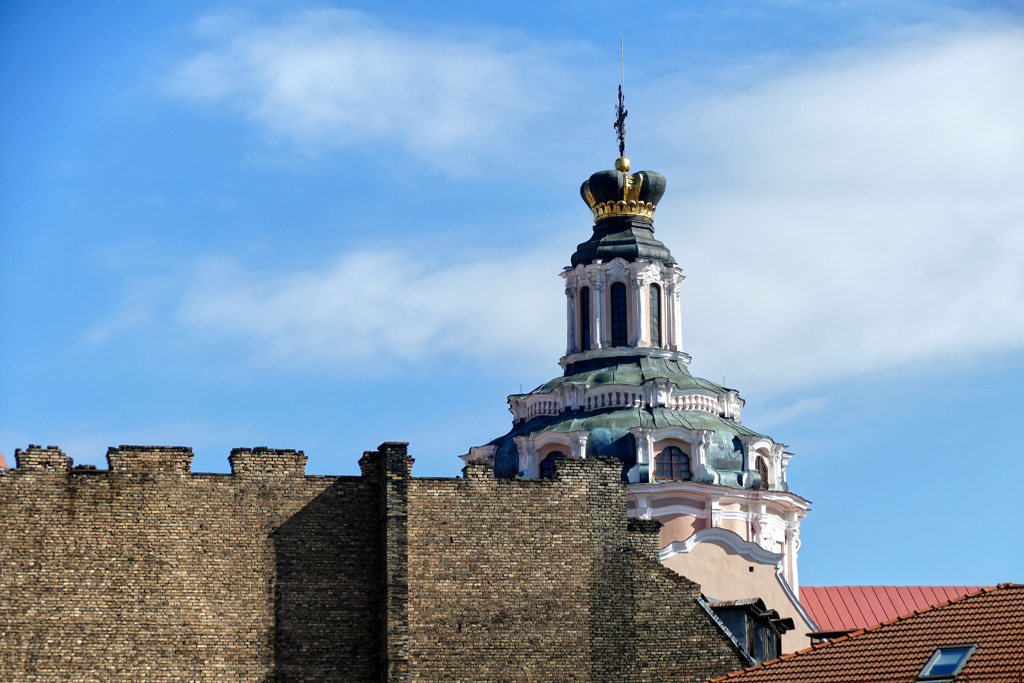
After the Jesuit order was banned in 1773, the Augustinians took over, later becoming a missionary order. After the 1831 uprising, the church was converted into the Orthodox Saint Nicholas Church in 1839 as part of the Tsarist administration’s Russification efforts. During this time, it was extensively rebuilt according to a design by the Russian architect Nikolai Chagin.

After the First World War, Lithuania took over the church. Jonas Mulokas designed and completed the crown of the dome in 1941, which today stands as a symbol of independence. In 1949, the Soviet authorities destroyed its interior and used the space as a storage room for wine and grain. After reconstruction in the mid-1950s, a Museum of Atheism was opened in the church in 1966. However, in 1989, the church was finally returned to the Jesuits and ceremoniously reopened in 1991.
Church of the Ascension
Perched atop Saviour’s Hill, the Church of the Ascension is a remarkable example of Baroque architecture. Built by Vincentian missionaries in the late 17th century, the church was envisioned as part of a larger religious complex that included a monastery, hospital, and guesthouse. This way, it was intended to serve both, the spiritual and social needs of the local community.
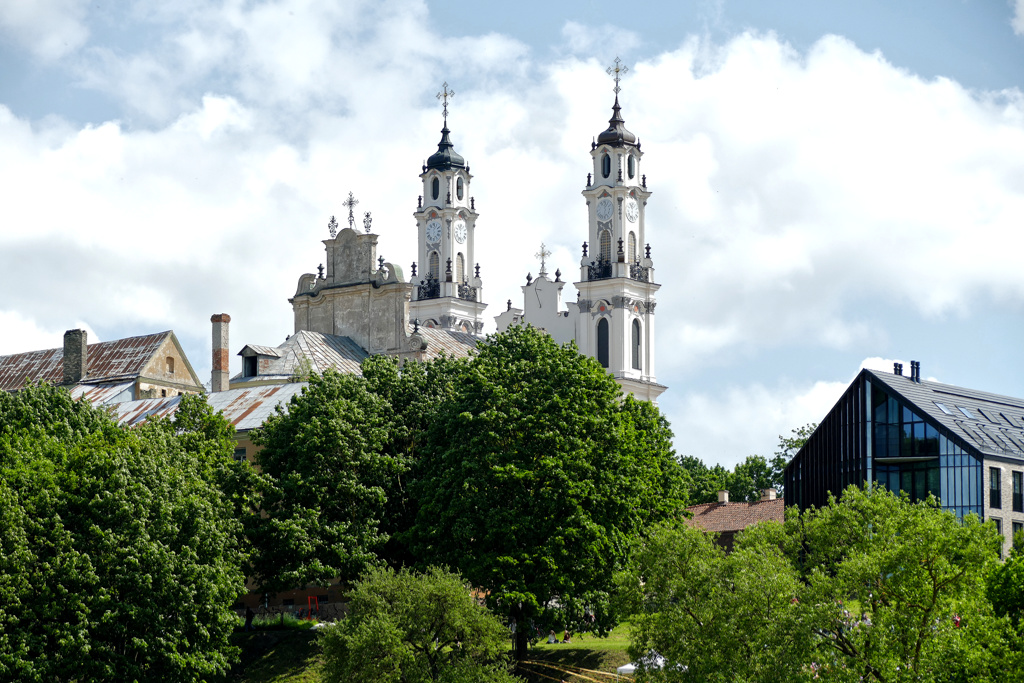
Construction began in 1695 but progressed slowly due to frequent wars, funding shortages, and natural disasters. A devastating fire in 1706 and an outbreak of plague delayed its completion until around 1730. In the mid-18th century, the building underwent a dramatic transformation. Under the guidance of architect Johann Christoph Glaubitz, the twin towers and a graceful Rococo porch were added, and the façade was richly adorned.
Over the centuries, the church and its adjoining monastery witnessed profound upheavals. In 1844, the Tsarist regime closed the monastery, and after several decades of sporadic use, the church was permanently shut down by Soviet authorities in 1948. It was then repurposed for secular use and served as a barracks, a psychiatric hospital, a gym, and even as a storage site for museum exhibits.
Following Lithuania’s independence, the church was returned to the Catholic community, and restoration work began. Although not yet fully reopened, the church and its surroundings are gradually coming back to life.
Saint Catherine’s Church
Saint Catherine’s Church is another stunning example of Vilnius Baroque and one of the city’s most elegant and theatrically designed churches.
Originally built in the early 17th century, the church underwent major reconstruction in the mid-18th century, transforming it into the ornate Baroque marvel seen today. The redesign was led by none other than Johann Christoph Glaubitz.
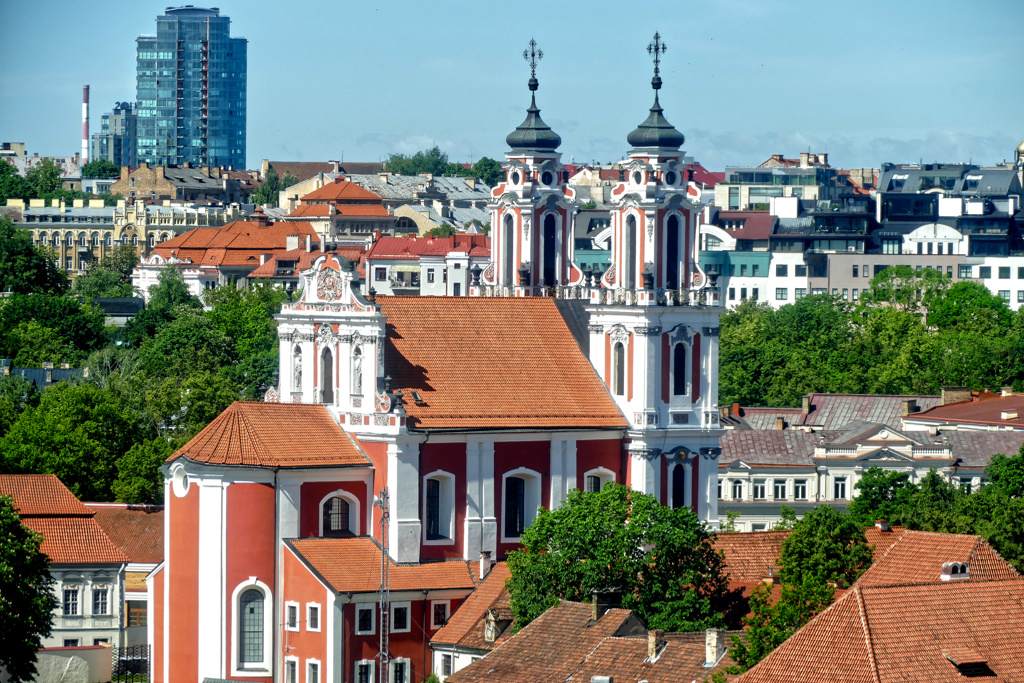
The façade is richly decorated with pilasters, volutes, and intricate ornamentation, embodying the lightness and theatricality typical of the late Baroque. Inside, although many original furnishings were lost over time, the space remains visually striking, with soaring ceilings and harmonious proportions.
For the longest time, Saint Catherine’s Church has not functioned as a traditional parish church. During the Soviet era, like many religious buildings in Vilnius, it was closed and repurposed. But its revival in the post-independence period stands as a symbol of Lithuania’s cultural resilience and commitment to preserving its architectural and spiritual heritage.
Today, it is one of Vilnius’s premier spaces for classical concerts, art performances, and cultural events due to its excellent acoustics.
Church of Saint Archangel Raphael
The Church of Saint Archangel Raphael stands on the right bank of the Neris River, just across from the historic old town. Though less internationally famous than some of the Baroque masterpieces in the city center, this church is a remarkable example of early 18th-century Vilnius Baroque and holds significant cultural and architectural value.
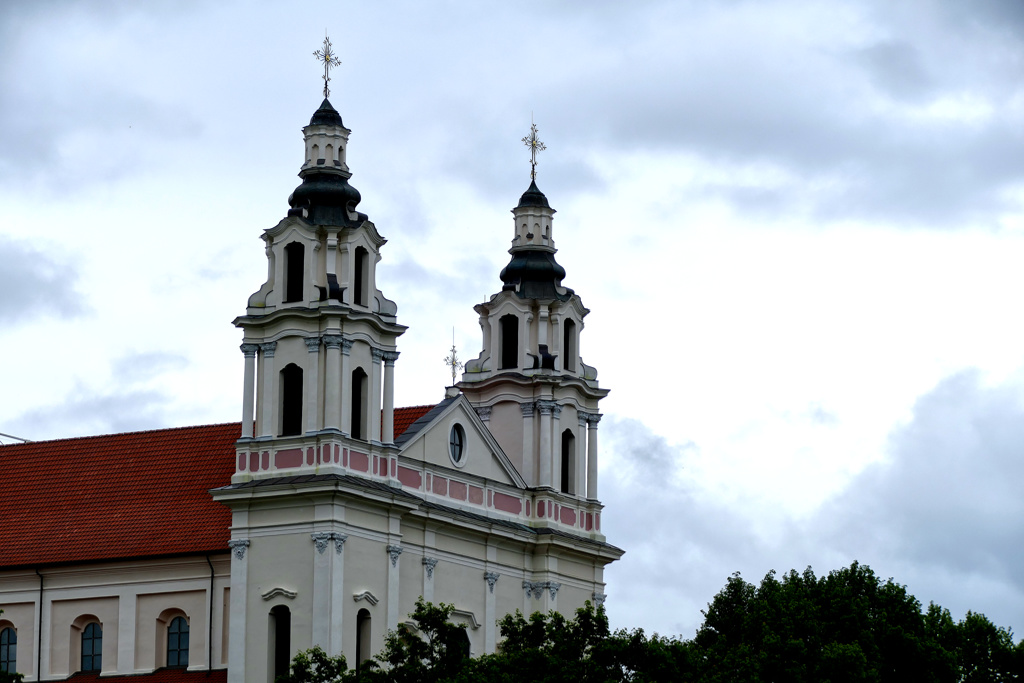
The church was built between 1702 and 1722 by the Jesuits. It was part of a larger complex, including a monastery and a college. Its location proves the Jesuits’ efforts to bring education and religious life to developing parts of the city. Its design reflects the Baroque ideals of clarity, grandeur, and emotional engagement.
The twin towers and classical pediment of the façade give the church a balanced, almost palatial appearance.
Following the suppression of the Jesuit Order in the late 18th century, the church underwent several transitions. In the Soviet era, like many churches in Vilnius, it was repurposed and fell into disuse. However, it was eventually restored and returned to religious use after Lithuanian independence.
Dominican Church of the Holy Spirit
Tucked away in the winding alleys of Vilnius’ so-called glass quarter, the Dominican Church of the Holy Spirit is one of the city’s most atmospheric and spiritually powerful Baroque landmarks. Though often overshadowed by more prominent structures, this church holds a rich history and a unique character.
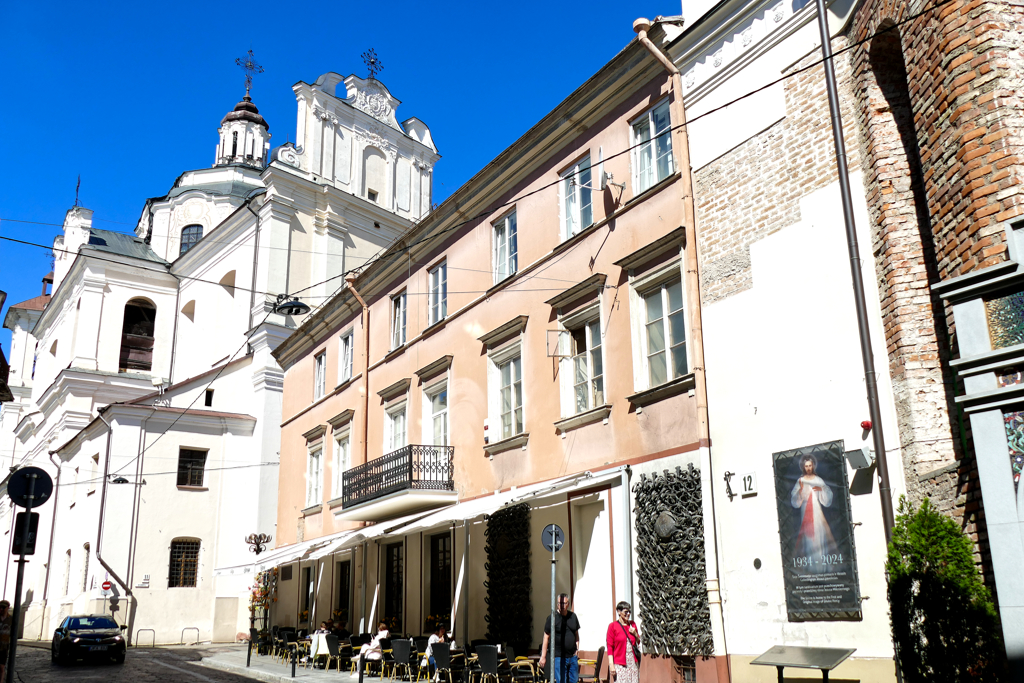
Originally built in the 14th century, the church was first a Gothic structure. In the 17th and 18th centuries, however, it underwent a significant Baroque transformation. Its current appearance was finalized in the mid-1700s, blending Baroque exuberance with Rococo delicacy. While the exterior is relatively modest, the interior is lavish, characterized by dramatic vaults, gilded altars, swirling stucco decoration, and vivid frescoes that seem to dissolve the boundaries between architecture and illusion.
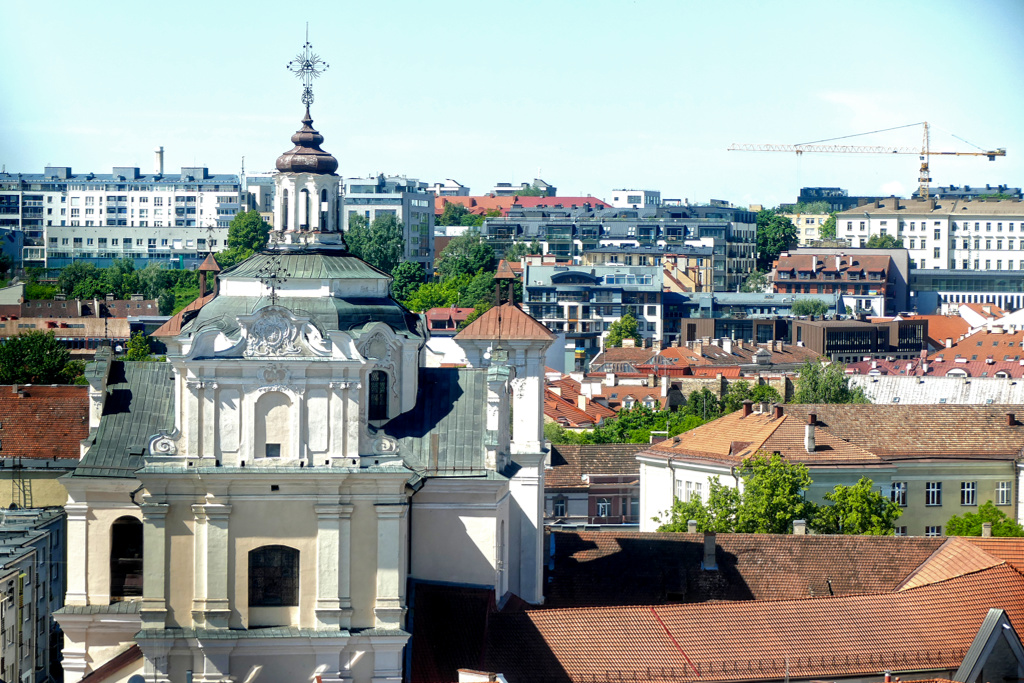
The church was once the spiritual and intellectual center of the Dominican Order in Vilnius. Also, the attached Dominican monastery played a pivotal role in theological education and missionary work throughout the Grand Duchy of Lithuania.
However, the Church of the Holy Spirit is also known for its underground crypts, holding the naturally mummified remains of hundreds of deceased.
Today, the Church of the Holy Spirit is the main house of worship of Vilnius’s Polish-speaking community.
Church of Saint John the Baptist and Saint John the Apostle and Evangelist
The Church of Saint John the Baptist and Saint John the Apostle and Evangelist, more commonly known as Saint Johns’ Church, is one of the most historically and architecturally significant landmarks in Vilnius. Located in the heart of the Vilnius University complex, it stands as a powerful symbol of both spiritual devotion and academic tradition.
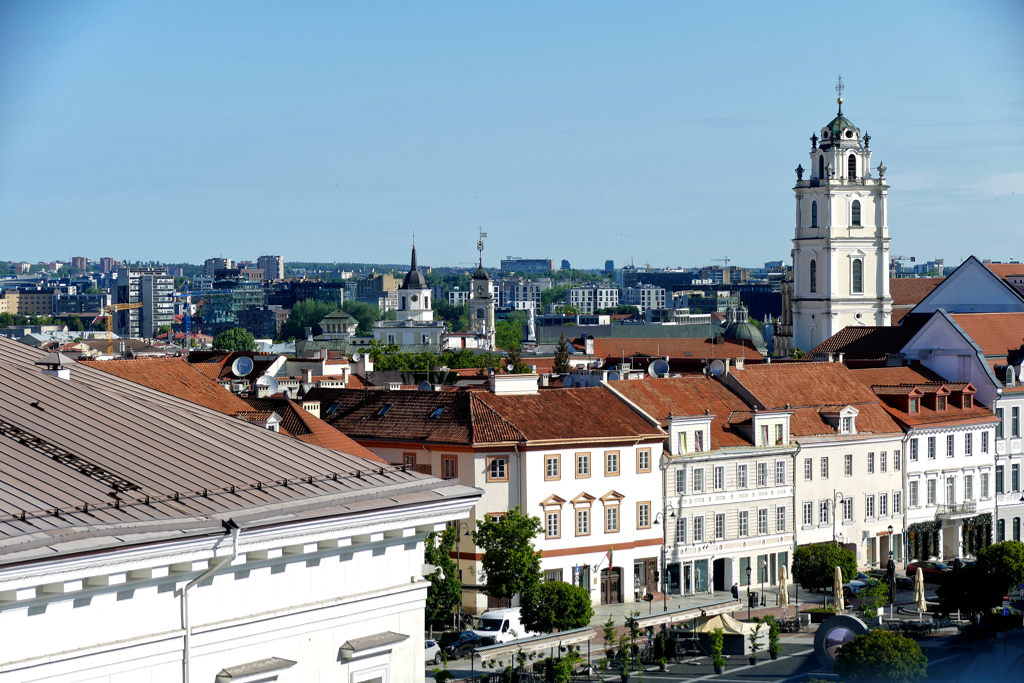
The history of Saint Johns’ Church goes back to the early days of Christianity in Lithuania. Construction began shortly after the official Christianization of the Grand Duchy in 1387, making it one of the oldest churches in Vilnius. Initially built in the Gothic style, the church was later modified. It got its ornate and theatrical appearance in the Baroque era, obviously. This architectural layering makes the church a kind of visual chronicle of Lithuanian history.
In the 18th century, Johann Christoph Glaubitz unified the church’s diverse structural elements and created its magnificent Baroque facade, one of the most beautiful ones in all of Vilnius.
Inside, the church is equally captivating. Its high, vaulted ceilings, delicately carved altars, and ornate stucco work reflect both Baroque elegance and the scholarly dignity of the university it belongs to. Saint Johns’ Church has been closely tied to Vilnius University since the 16th century. It has served as the university’s church, hosting religious ceremonies, academic celebrations, and cultural events. Over the centuries, many of Lithuania’s most influential scholars and poets have attended this prestigious institution.
The bell tower rises 68 meters high, which makes it one of the tallest structures in Vilnius. From here, you have the best panoramic views of the city.
5 Most Beautiful Orthodox Churches
Obviously, Vilnius is primarily known for its impressive Roman Catholic churches in the iconic Vilnius Baroque style. However, for historical and geographical reasons, it also has a rich Orthodox heritage. Magnificent Orthodox churches can still be found in the city today. They provide a spiritual home, particularly for the Russian and Belarusian Orthodox communities. Having already introduced the Orthodox Church of the Holy Spirit above, here are five of the most magnificent examples of Orthodox churches in Vilnius.
Church of Saint Nicholas
The Orthodox Church of Saint Nicholas, located at the beginning of Pilies Street, is the oldest surviving Orthodox church in the city. Its origins date back to the 14th century. Originally built around 1340 on the site of a wooden chapel, it was later rebuilt in brick by Orthodox noblemen.
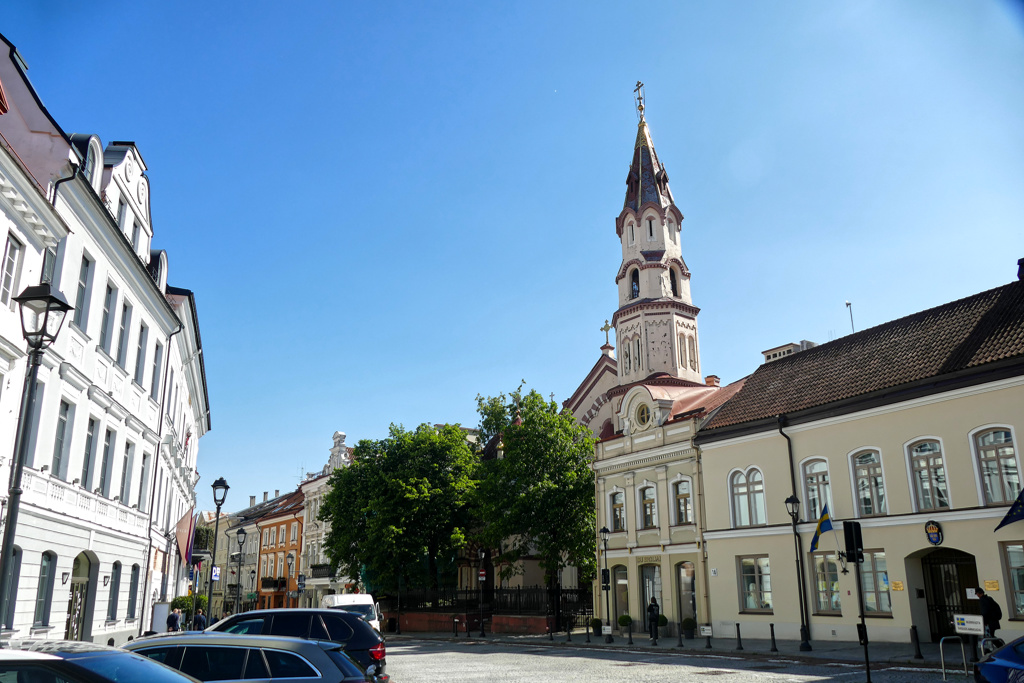
Over the centuries, the church has passed between Orthodox and Uniate parishes, surviving fires, political changes, and architectural remodeling. Its current Neo-Byzantine appearance dates from the 1860s, when it was rebuilt under Russian rule. Still in use today, the church is known for its serene atmosphere, historic mosaics, and multifaceted architectural style, reflecting Vilnius’s complex religious past.
Cathedral of the Theotokos
The Cathedral of the Theotokos was built during the reign of the Grand Duke of Lithuania Algirdas for his Orthodox second wife Uliana of Tver in 1346.
This makes it one of the most ancient churches of Vilnius, built even before the Christianization of Lithuania.

After the conversion of Lithuania to Roman Catholicism, the Orthodox cathedral was protected by princes Konstanty Ostrogski and Konstanty Wasyl Ostrogski, who restored it after the collapse of the dome in 1506.
In 1748, the cathedral was abandoned after a major fire and the building was used for various other purposes. It was reconstructed in the Baroque style in 1785.
In 1808, a local prelate sold the neglected building to the Vilnius University, which had the building thoroughly modernised in 1822 in the Neoclassical style by Karol Podczaszyński. After that, the building hosted an anatomical theatre, library and other university facilities for half a century.
The Cathedral of the Theotokos was damaged during the Second World War but was restored in 1948, although its renovations were not completed until 1957. Today, the Cathedral belongs to the Russian Orthodox Church. Its services are attended mostly by ethnic Russian and Belarusian residents of Vilnius.
Orthodox Church of Saint Paraskeva
The Orthodox Church of Saint Paraskeva, located in the heart of the Old Town, is a small but historically significant church. Originally built in the 14th century, it is one of the oldest Orthodox churches in the city. Over the centuries, it has been destroyed and rebuilt several times. Particularly significant was the 19th-century reconstruction in the Neo-Byzantine style, which gives the church its present appearance.
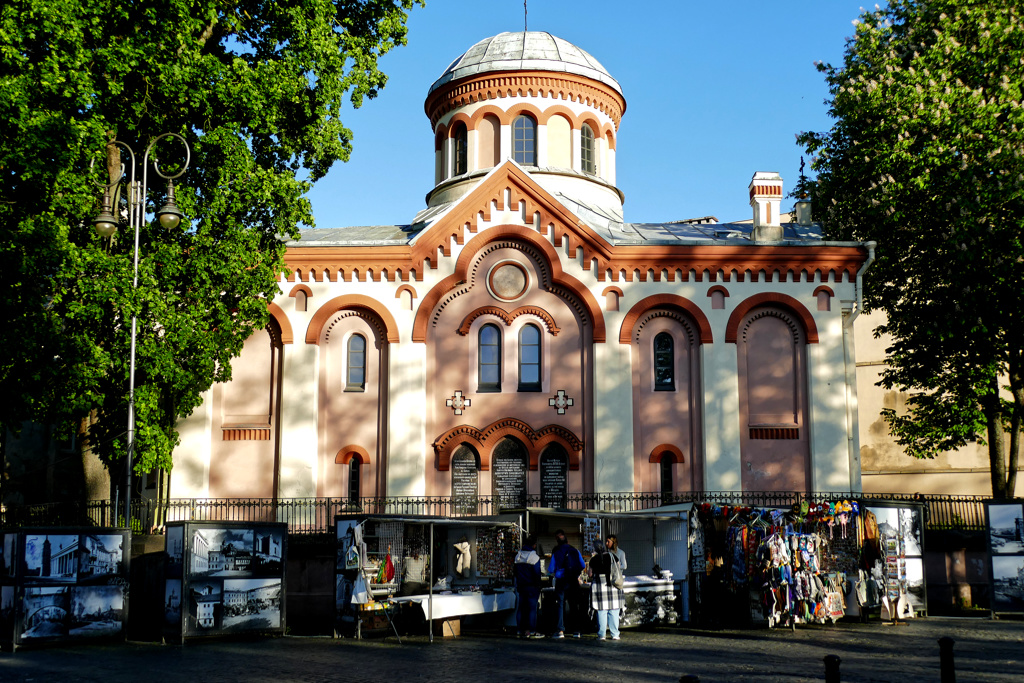
Legend has it that in 1705, during a period of Russian rule, the first Black African in Russia, an ancestor of Alexander Pushkin, was baptized here.
Today, the church continues to serve as a place of worship and is valued for its historical heritage and tranquil interior.
Church of Saints Constantine and Michael
The Russian Orthodox Church of Saints Constantine and Michael in Vilnius stands in the Naujamiestis district. Built in 1913 to honor the 300th anniversary of the Romanov dynasty, it is also often called the Romanov Church.
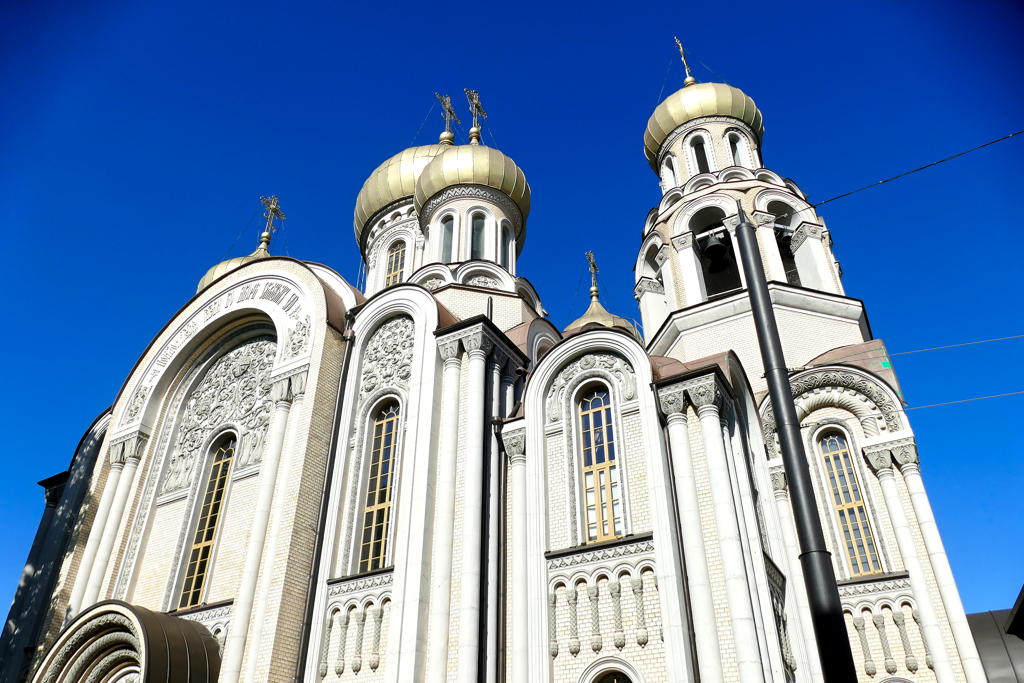
Designed in a blend of Rostov and Suzdal historicist styles, the church is noted for its beautiful gilded onion-shaped domes. While the exterior is rich in arches and stucco ornamentation, the interior is rather simple with wooden iconostasis and chandeliers.
To this date, this beautiful church, with its distinctive domes and historical ties to the Romanov dynasty, remains a vibrant place of worship and a striking architectural landmark, and an active parish within the Russian Orthodox Diocese of Lithuania.
My Tip
This church is located outside the old town, making it a more challenging visit than other churches that I’m introducing in this post. While you’re there, however, be sure to continue a little further down and turn into M. K. Čiurlionio gatve. Here, you can stop for a refreshing drink at the legendary Taste Map Coffee Roasters. Nevertheless, you can find Taste Map Coffee Roasters and 14 other recommended coffee houses in Vilnius in my post Best And Most Beautiful Coffee Houses in Vilnius.
Orthodox Church of Our Lady of the Sign
The Orthodox Church of Our Lady of the Sign rises majestically in the Vilnius district of Žvėrynas. Built in 1903 in an elegant Neo-Byzantine style, it originally housed a school and library for the local community.

Interestingly, it remained open during both World Wars and continued to serve as a parish church even under Soviet rule.
To this day, it serves as a gathering place for the active Orthodox community. Services and community events are held here, and the spiritual and architectural heritage of Vilnius’s Orthodox believers is preserved here.
My Tip
The Orthodox Church of Our Lady of the Sign is located in the Vilnius district of Žvėrynas. If you’re heading to these outskirts of the city center, be sure to explore more of the area in addition to the church. In fact, it is one of the most picturesque and characteristic districts of Vilnius, known for its wooden architecture, its almost village-like atmosphere, and its green surroundings. For a well-deserved break, the delightful Café Espresinė is a great place to stop. I introduce Espresinė and 14 other recommended coffee houses in Vilnius in my post Best And Most Beautiful Coffee Houses in Vilnius.
How to Get Around
The churches in the old town can be easily reached by walking. Since some of the main sights are located in hilly areas and many streets are cobblestoned, I can’t really recommend exploring the city by bike. Nevertheless, it is an option.
Like virtually all European cities, Vilnius has a well-developed public transportation system, consisting primarily of buses and trolleybuses. The network is comprehensive and, above all, very affordable. Interestingly, it is supplemented by privately operated minibuses. Those are integrated into the official system, but run mainly on the less frequented routes. However, these minibuses are faster than regular buses and have fewer stops.
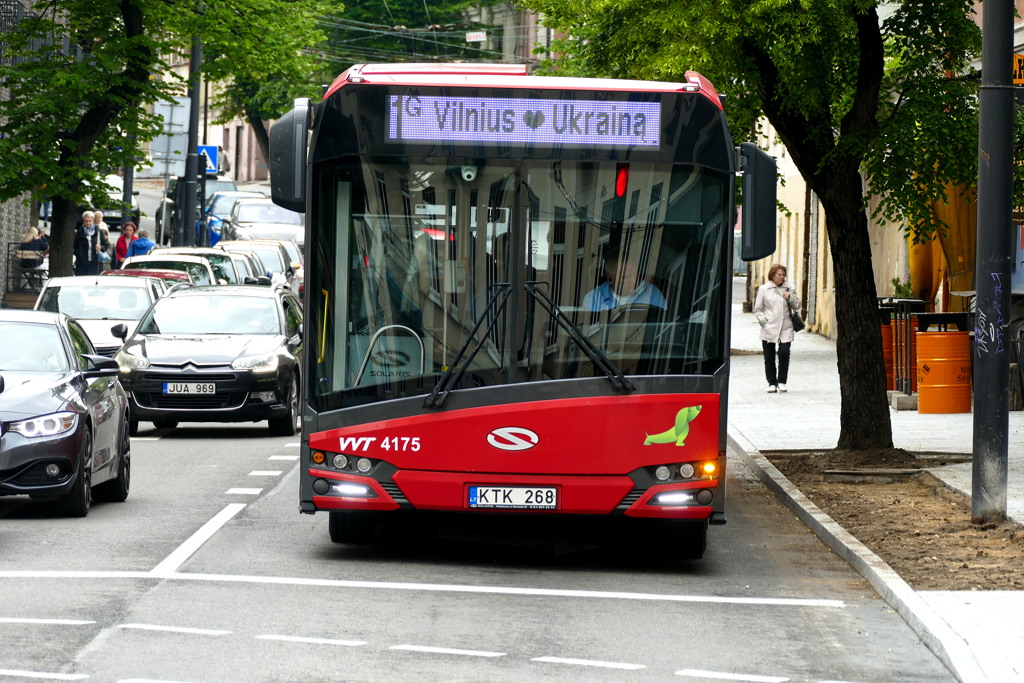
Regular bus service runs from 5:30 a.m. to midnight. After that, night buses run throughout the night with a limited schedule.
A single ticket costs 0.65 €uros in an app, whereas a paper ticket costs 0.90 €uros. For 5 €uros, you can get a 24-hour day ticket, and a 3-day ticket costs only 8 €uros. Note that apparently, the app works only with Lithuanian phone numbers, and everything is in Lithuanian. Therefore, I’d argue that the best way to buy tickets is by getting the Vilniečio Card. There are ticket machines at some stops, and paper tickets are also available on the bus. Keep in mind that you cannot pay cash but need to use a contactless means of payment.
Visiting Organized
I’m an avid solo-travelling woman. Since solo travel doesn’t equal solitude, I love to join organized tours here and there. They allow me to meet fellow travellers – for just a short moment or a lifelong friendship.
Therefore, here is a great tour including the most iconic churches in Vilnius. Especially if you have only a short amount of time, they’ll enable you to leave the planning and organizing to others and just enjoy the city to the max*:
So yes, these are the most beautiful churches in Vilnius. If you need further inspiration for your visit to the city, check out my post What to See on an Unforgettable Weekend in VILNIUS where you’ll find tons of tips. In my post Best And Most Beautiful Coffee Houses in Vilnius, I’m introducing the 15 most alluring coffeehouses for a formidable break during your sightseeing.
If urban art is your jam, make sure to check out the comprehensive post on Best Street Art in VILNIUS. In my post La Vie en Rose: How Vilnius Celebrates Soup with Exuberance, I’m inviting you to join the fun during Vilnius’ annual Pink Soup Fest.
And finally, if you have only a short stay like for instance a layover in Vilnius, make the best of it with my guide for 24 hours in VILNIUS. There you’ll find a complete itinerary for a sunny day as well as for a rainy day.
Map
On this map, you can see exactly where Vilnius’ most glorious churches are located. Clicking on the slider symbol at the top left or the full-screen icon at the top right will display the whole map, including the legend.
Pinnable Pictures
If you choose to pin this post for later, please use one of these pictures:
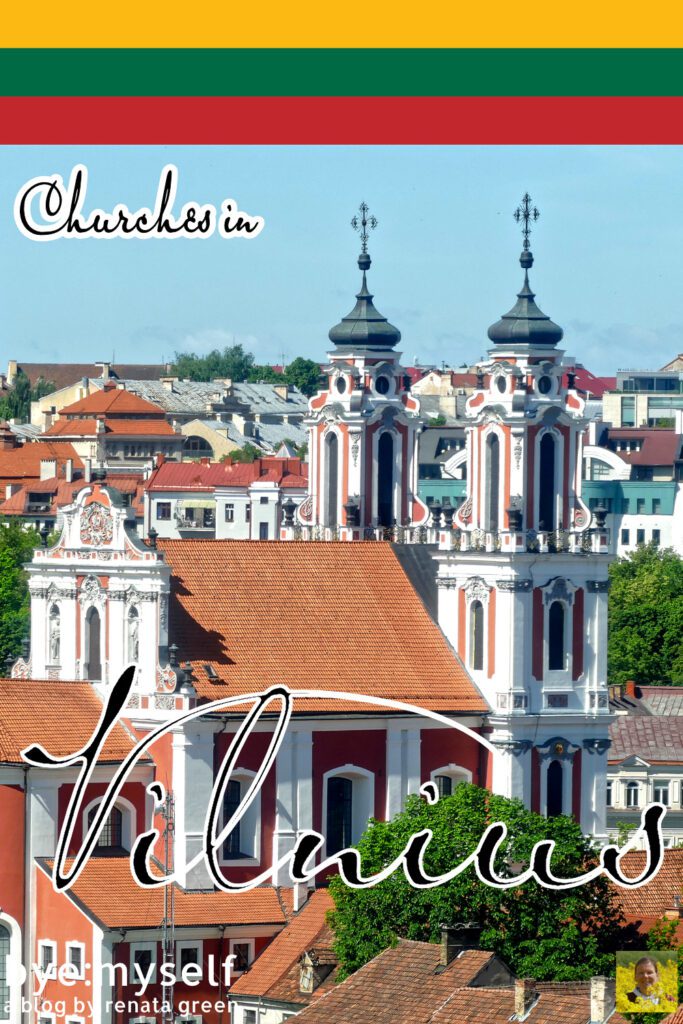
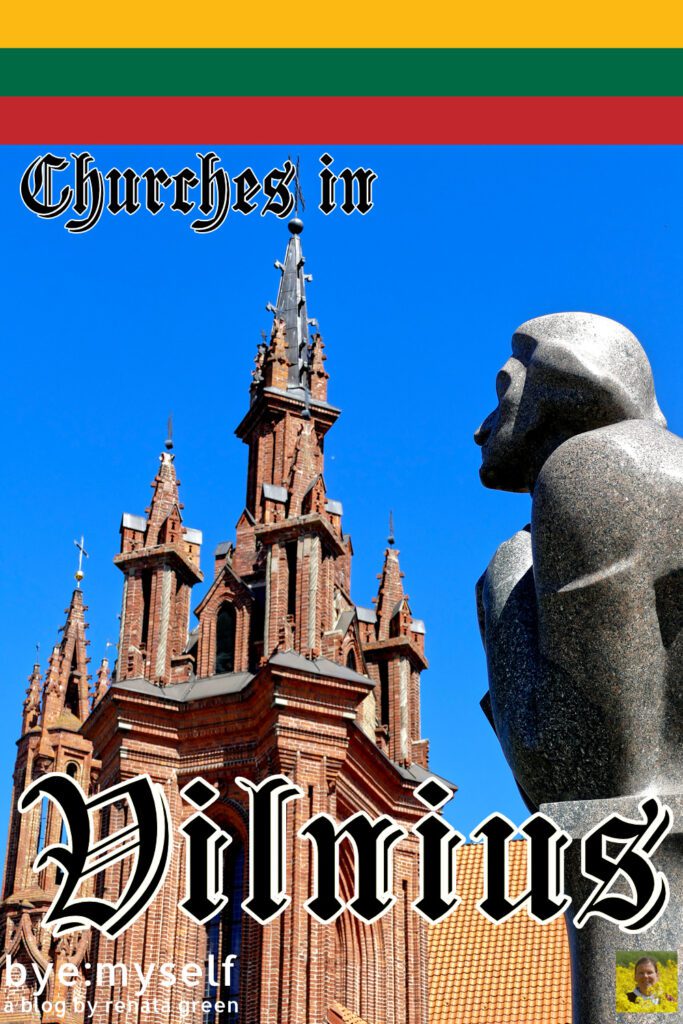
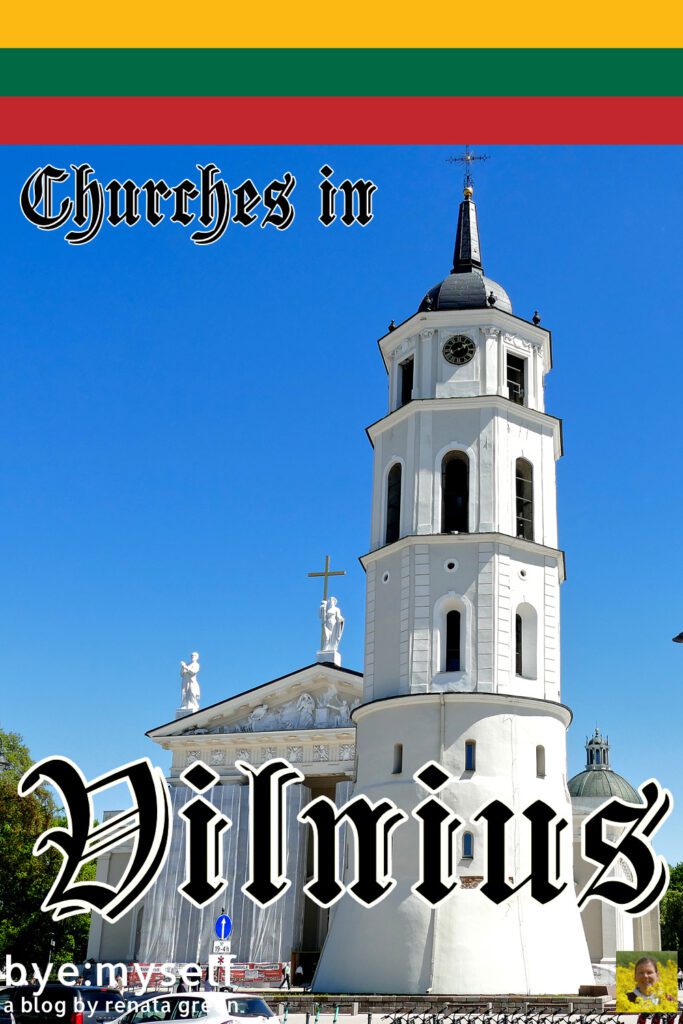
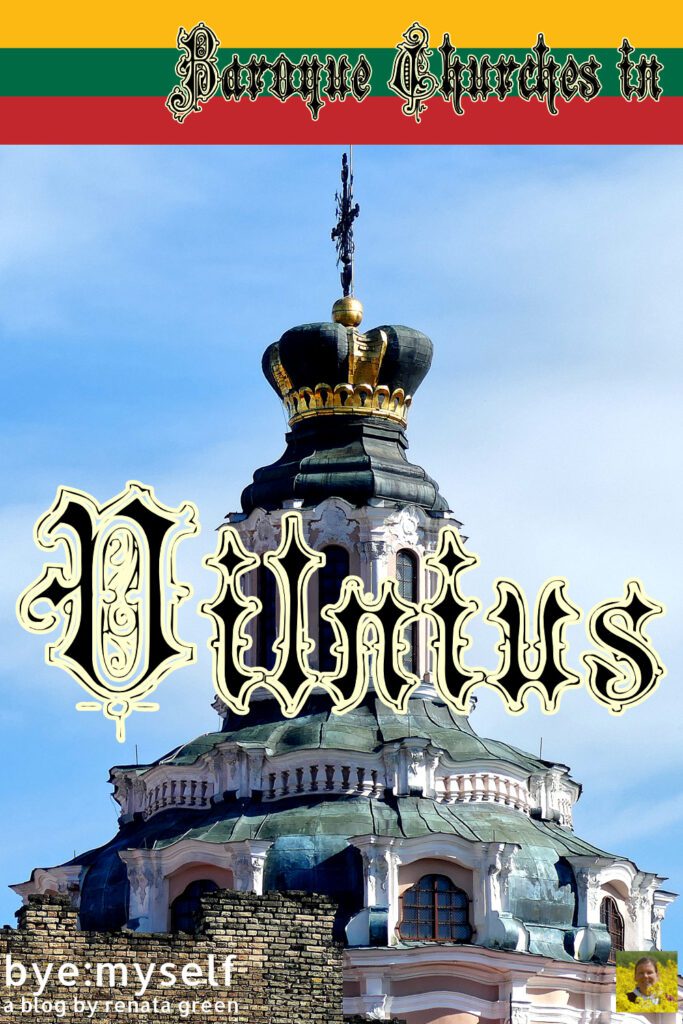
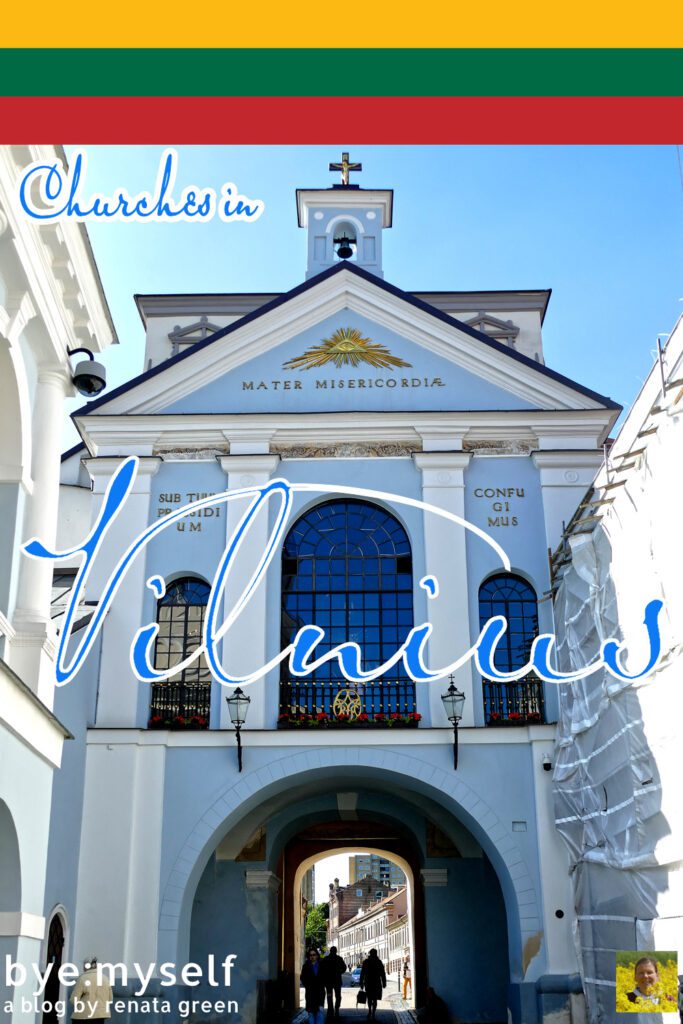
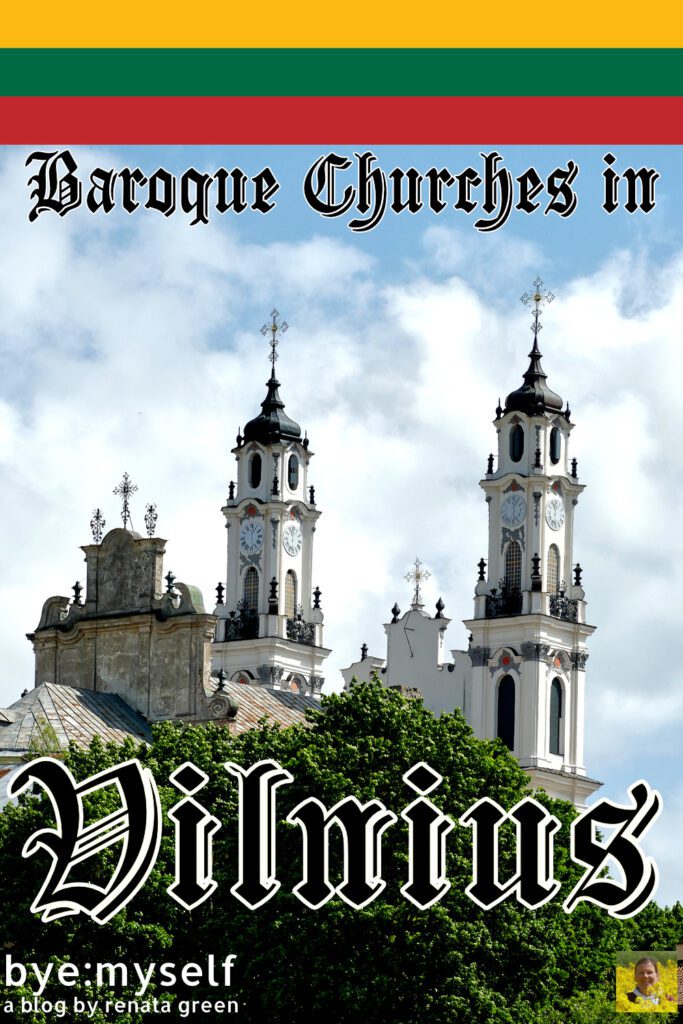
Did You Enjoy This Post? Then You Might Also Like These:
Baroque Splendor And River Romance: The Must-Sees of DRESDEN
The Valley of the Temples of Agrigento And La Villa Romana del Casale di Piazza Armerina: A Day Trip Not to Miss
What to See on an Unforgettable Weekend in VILNIUS
An Easy Day Trip to the Hahoe Folk Village from Andong
BASEL and the Rehberger-Trail – time to wonder, time to wander
10 Most Beautiful Palaces in the Marais Neighborhood of Paris
One Day in CATANIA, Sicily’s Building Ground of Grand Palaces
50 Most Beautiful Palaces in Venice
* This is an affiliate link. If you book through this page, not only do you get the best deal. I also get a small commission that helps me run this blog. Thank you so much for supporting me!

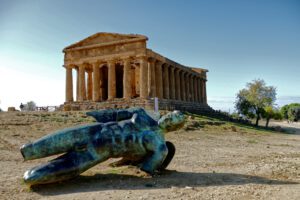


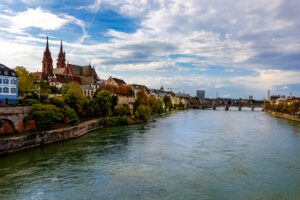
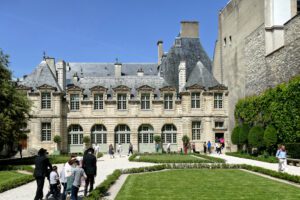
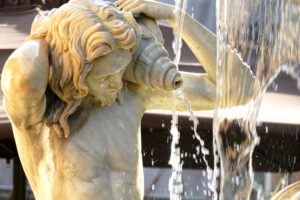
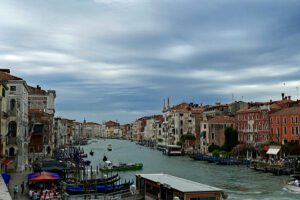
I want to to thank you for this very good read!! I absolutely enjoyed every
little bit of it, especially since we are planning a road trip through Lithuania soon.
That sounds amazing! Hope you have a great time – save travels!